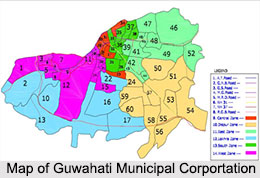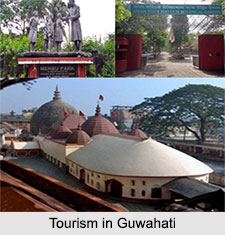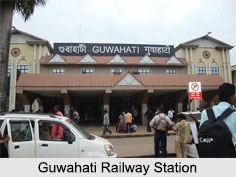 Considered to be the "gateway to north east India", Guwahati in the Kamrup District is one of the largest cities of Assam and also the largest metropolis in the north east India. Located on the foothills of the Shillong plateau, the city lies on the south bank of the Brahmaputra River. Thus, it is a major riverside port and Assam"s principal commercial centre. Located in the circuit city region is Dispur, which is a part of Guwahati, it serves as the capital of Assam.
Considered to be the "gateway to north east India", Guwahati in the Kamrup District is one of the largest cities of Assam and also the largest metropolis in the north east India. Located on the foothills of the Shillong plateau, the city lies on the south bank of the Brahmaputra River. Thus, it is a major riverside port and Assam"s principal commercial centre. Located in the circuit city region is Dispur, which is a part of Guwahati, it serves as the capital of Assam.
Etymology of Guwahati
Combining the ancient cities of Pragjyotishpura and Durjaya, Guwahati used to be the erstwhile capital of the Hindu kingdom of Kamarupa. Earlier known as Pragjyotishpura, which means the "Light of the East", the name Guwahati is derived from the Assamese words "Guwa" meaning areca nut and "Haat" meaning market.
 History of Guwahati
History of Guwahati
There have been mentions of the city of Guwahati in the sacred Hindu epics and religious texts like the Puranas. Rock inscriptions found in the Nilachal Hills dating back to the 5th century AD, makes Guwahati one of the earliest found in the north east India. As per the Hindu epic, Mahabharata, Guwahati was once the capital city of the demon kings, Narakasura and Bhagadatta of the Pragjyotisha Empire.
Over the centuries, the city changed hands several times from the Kamata kingdom to the Ahom dynasty and eventually under the Mughal reign before finally it became a part of the British Empire. Guwahati played an active role during the independence struggle of India and was the birthplace of activists such as Tarun Ram Phukan.
Currently, over a century later, Guwahati spreads over an area of 328 sq. km and is now one of the fastest growing cities with a population of over 1 million.
Climate of Guwahati
With a humid sub tropical climate, Guwahati experiences an average annual temperature of 22 degree Celsius and an average annual rainfall of 1698 mm. The month of August is the warmest with a maximum temperature of 29 degree Celsius and January is the coldest month of the year with an average temperature of 15 degree Celsius. The driest month is December, with 6 mm of rain. In June, the precipitation reaches its peak, with an average of 315 mm.
Demographics of Guwahati
One of the fastest growing cities in the country, it is being estimated that by the year 2025, Guwahati metro will house 2.8 million residents. As per the reports of Census India 2011, the total population of the city was 962,334 out of which 498,450 are males and 463,884 are females.
The population of children between the ages of 0 to 6 years is 9.40 percent. The sex ratio has been recorded to be 933 females per 1000 males and the child sex ratio to be 940 girls per 1000 boys.
The city also had an average literacy rate of 91.47 percent with male literacy at 94.24 percent and female literacy at 88.50 percent. The prime religion followed in the city is Hinduism with a majority of almost 84 percent followers.
 Economy of Meghlaya
Economy of Meghlaya
The city of Guwahati is an important river port and Assam"s principal commercial centre. The manufacturing sector in Guwahati contributes a substantial share to the economy of the city. Petroleum manufacturing is an important economic activity in the city. The city"s oil refinery is the most important manufacturing industry in the city. Guwahati also has a state farm, and its industries include tea processing, milling of agricultural products, and soap manufacturing.
Tourism in Guwahati
Commercially vibrant, the tourism in Guwahati is still flourishing with its various temples, museum and zoological garden. Aptly known as the "Temple Land of Assam", the temples in Guwahati reveal the diversified culture and heritage of the state. Hindu temples like the Kamakhya Temple, Basistha Temple , Lankeshwar Temple, etc are not only famous for their religious aspect; they are also famous for being major places of tourist attractions in the city. Other places of tourist attractions include the Nehru Park, Guwahati Zoo, etc. The tourism in Guwahati explores the character and local flavour of the region.
Visiting Information on Guwahati
The city of Guwahati and the north eastern region falls under the Northeast Frontier Railway (NFR) Zone of the Indian Railways. The Guwahati railway station, located in Paltan Bazaar area of Guwahati, is the major railway station of the city. The nearest airport is the Lokpriya Gopinath Bordoloi International Airport, in Borjhar, about 20 km west from the heart of the city. And via roadways, the National Highway 27 connects Guwahati with the states of West Bengal, Bihar and rest of India.



















